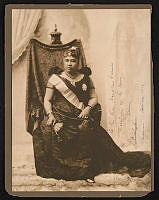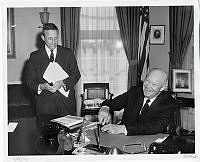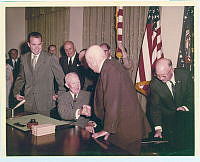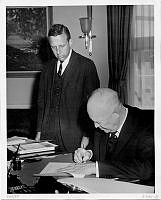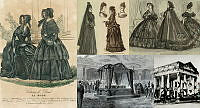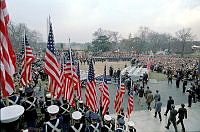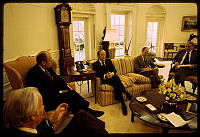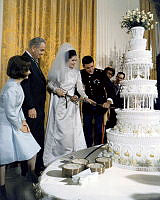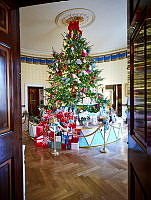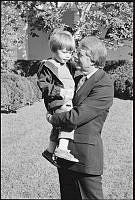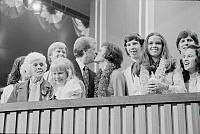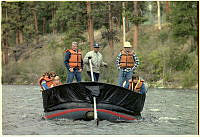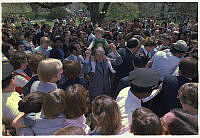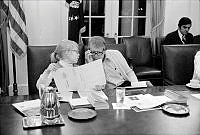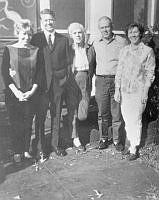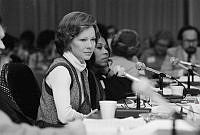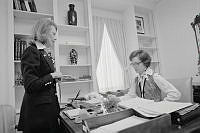Rubenstein Center Scholarship
The Red Room in the Polk White House
Gallery
-

The State Floor of the White House during Thomas Jefferson's presidency, drawn by architect Benjamin Henry Latrobe.
Library of Congress -

A computer-generated image of the Polk Red Room looking south from the doorway of the Cross Hall.
David Ramsey/White House Historical Association -

A computer-generated image of the Polk Red Room looking southwest.
David Ramsey/White House Historical Association -

A black and white photograph taken by Frances Benjamin Johnston during the Chester A. Arthur administration. The room was redecorated by acclaimed New York designer Louis Comfort Tiffany in 1882.
Library of Congress -

The Red Room after the 1902 redecoration by McKim, Meade & White, ca. 1904.
Library of Congress -

The Red Room during the Harry S. Truman administration, ca. 1948.
Library of Congress -

The Red Room after the 1962 redecoration by First Lady Jacqueline Kennedy.
John F. Kennedy Presidential Library and Museum/NARA -

The Red Room during the Ronald Reagan administration in 1987.
White House Historical Association -

The Red Room during the Barack Obama Administration in 2010.
White House Historical Association
Today’s State Floor of the White House has rooms designated by color (Green, Blue, and Red), purpose (State Dining Room and Family Dining Room), and directional orientation (East Room), but this was not always so. During the early administrations, each president used the rooms of the State Floor differently. John Adams, whose residence in the White House lasted only four short months, worked in an office on the Second Floor. He held his presidential levees in the State Dining Room and used the Red Room as a family breakfast parlor, outfitting the room with a mahogany table and accompanying chairs.1
After Adams’s defeat in the election of 1800, his successor Thomas Jefferson repurposed the rooms to suit his needs and highlight his political beliefs. Rejecting the formality of the Adams levee, Jefferson turned the space into his office and library. The Red Room, identified in architect Benjamin Henry Latrobe’s drawing as the “antechamber,” functioned as a waiting room for Jefferson’s visitors outside his office. During the presidency of James Madison, First Lady Dolley Madison transformed the walls of the “antechamber” with a bright, sunflower color. Washington socialites who attended Dolley’s famed Wednesday night receptions referred to the space as “Dolley’s salon” and the “yellow drawing room.” Subsequent presidents and first ladies generally used the room as a parlor or receiving room. The famous full length Gilbert Stuart portrait of George Washington found its way into the room during the presidency of James Monroe. As a result, visitors sometimes referred to the room as the “Washington parlor."2
The “Red Room” first appeared during the presidency of James K. Polk. The president asked the wealthy, Washington, D.C. banker William W. Corcoran to assist First Lady Sarah Polk with the White House redecoration. As an art collector and later founder of the Corcoran Gallery of Art, he was very knowledgeable in the latest aesthetic movements and fashions of the mid-nineteenth century. Corcoran traveled to New York, where he selected red velvet curtains, rocking chairs, ottomans, armchairs, and lounges featuring various shades of green and red.3 Crafted by New York cabinetmakers John and Joseph W. Meeks in the Louis XV style, the furniture suite consisted of rosewood armchairs, two couches, and ten chairs upholstered in crimson plush.4 While Corcoran obtained the pieces, everything—from designs to types of fabric—was sent to Sarah for her approval before purchase. These furnishings were delivered to the White House sometime in late 1845. Elizabeth Dixon, wife of Connecticut congressman James Dixon, recorded her observations of the revamped room after a December 1845 dinner at the White House. Elizabeth referred to it as the “Receiving or Red Room,” remarking that the space was “warm and comfortable.”5 The following summer a reporter for Dwight’s American Magazine noted the “crimson silk hangings…chairs of antique patterns, and ottomans, and couches of the richest coverings.” However, this particular writer called the space “a square room” and one of a “suite of apartments devoted to the reception of visitors,” suggesting that while the room was now red, it was not yet popularly known as the “Red Room.”6 Despite such detailed sources, there are no known existing images of the Polk-era Red Room. In a recent article for White House History, architect David Ramsey used these accounts to create computer-generated images of the room as it appeared in Polk’s time.7
During a New Year’s Day reception at the Polk White House in 1849, one visitor and his party waited in the long line to shake hands with the president and first lady. As the group shuffled through the Entrance Hall they entered “what I believe is called the ‘Red Room,’” wrote the correspondent. They followed the reception line into the oval-shaped Blue Room, where “President Polk and First Lady Sarah stood, along with the president’s secretary and nephew James Knox Walker. Surrounded by a half dozen aides, the Polks welcomed their guests to the White House, shaking the hands of some three or four thousand people.”8
While this particular columnist articulated the new name of the room, it took some time for “Red Room” to become more commonly used. As more first families, politicians, dignitaries, and citizens experienced the Red Room of the White House, the term gradually began to stick. President-elect Rutherford B. Hayes was sworn into office in the “Red Room” on Sunday, March 4, 1877, at the request of President Ulysses S. Grant. Accounts of receptions at the White House mention the “Red Room” more frequently afterwards, but it was the later redecorations of the room by Louis Comfort Tiffany in 1882 and Charles McKim in 1902 that ensured that the space would keep its moniker.9 As future administrations entered the Executive Mansion in the twentieth century, the walls of the “Red Room” represented a rich, crimson tradition for the space. While everything in the room—carpeting, curtains, furniture, wallpaper, decorative objects—would change over time, the room’s red color survives to the present.













